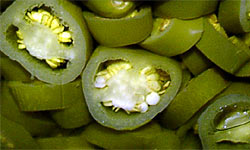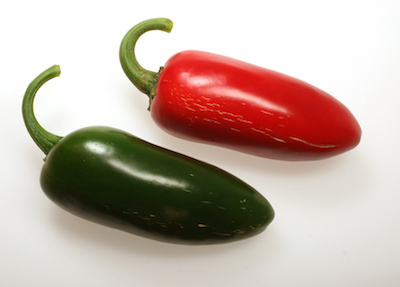By Dave DeWitt
Fiery Foods & BBQ Central Recommendations
Chile Pepper Bedding Plants… over 500 varieties from Cross Country Nurseries, shipping April to early June. Fresh pods ship September and early October. Go here
Chile Pepper Seeds… from all over the world from the Chile Pepper Institute. Go here
Photo by Harald Zoschke
The Plant
This chile was named after the city of Xalapa in Veracruz, Mexico, where it is no longer commercially grown. This chile pepper is a pod type of Capsicum annuum. Jalapeños usually grow from 2 ½ to 3 feet tall. Jalapeños have a compact single stem or upright, multibranched, spreading habit. The leaves are light to dark green and measure about 3 inches long and 2 inches wide. The flower corollas are white with no spots. The pods, which are conical and cylindrical, are pendant and measure about 2 to 3 inches long and 1 inch wide. They are green (occasionally sunlight will cause purpling), maturing to red, and measure between 2,500 and 10,000 Scoville Units. The brown streaks, or “corking” on the pods are desirable in Mexico but not so in the U.S.
Agriculture
In Mexico, commercial cultivation measures approximately 40,000 acres in three main agricultural zones: the Lower Palaloapan River Valley in the states of Veracruz and Oaxaca, northern Veracruz, and the area around Delicias, Chihuahua. The later region grows the American jalapeños, which are processed and exported into the U.S. Approximately 60% of the Mexican jalapeño crop used for processing, 20% for fresh consumption, and 20% in production of chipotle chiles, smoked jalapeños.
In the United States, approximately 5,500 acres is under cultivation, with Texas the leading state for jalapeño production, followed by New Mexico. Home gardeners should remember that the U.S. varieties of jalapeños flourish better in semi-arid climates–ones with dry air combined with irrigation. If planted in hot and humid zones in the U.S. during the summer, the yield of such jalapeños decreases and so Mexican varieties should be grown. The growing period is 70 to 80 days, and the yield is about 25 to 35 pods per plant.
Recommended Mexican varieties are ‘Típico’ and ‘Peludo’; recommended U.S. varieties are ‘Early Jalapeño’ (hot) and ‘TAM Jalapeño’ (mild).
Culinary Usage
Jalapeños are one of the most famous chile peppers. They are instantly recognizable and a considerable mythology has sprung up about them, particularly in Texas. The impetus for the popularity of jalapeños starts from a combination of their unique taste, their heat, and their continued use as a snack food.
In 1956, Newsweek magazine published a story on a pepper-eating contest held in the Bayou Teche country of Louisiana, near the home of the famous Tabasco sauce. The article rated the jalapeño as “the hottest pepper known,” more fiery than the “green tabasco” or “red cayenne.” Thus the Tex-Mex chile was launched as the perfectly pungent pepper for jalapeño-eating contests, which have proliferated all over the country.
Many jalapeños are used straight out of the garden in salsas. Others are pickled in escabeche and sold to restaurants and food services for sale in their salad bars. Jalapeños are processed as “nacho slices,” and “nacho rings” that are served over nachos, one of the most popular snack foods in arenas and ball parks. Jalapeños are commonly used in commercial salsas and picante sauces, which process a large percentage of the imports from Mexico.
 Essential for Nachos: Sliced Jalapeños
Essential for Nachos: Sliced Jalapeños





